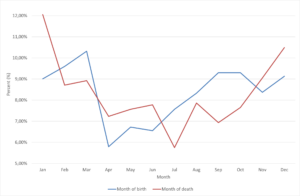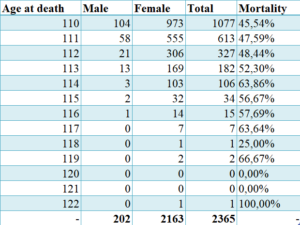Introduction
Previous research on centenarians has indicated the existence of a phenomenon known as the “mortality plateau” (Modig et al., 2017). Mortality appears to stabilize at around 50 percent annually from the age of 100 and upwards. However, few studies have investigated whether this holds true for supercentenarians (individuals aged 110 and above) as well (Barbi et al., 2018). This can mainly be attributed to the inadequate dataset of supercentenarians in the past, with the historic lack of supercentenarian data preventing proper statistical analysis.
While still incomplete, efforts are underway to update historical supercentenarian data to obtain a more accurate depiction of past and present lifespans. An additional benefit of gathering and validating supercentenarian age claims is the opportunity to analyze mortality trajectories and interpret the mortality of exceptionally old individuals.
Moreover, it has been previously noted that seasons influence human mortality, with a higher number of deaths occurring during the colder months of the year (Rau, 2007). Several factors contribute to increased mortality during colder months (Drefahl, 2005). Climate, greater proximity to others, and access to nutrition have all been observed to affect mortality patterns. Seasonality in mortality naturally depends on the climate of the country in which a supercentenarian resides, with some countries experiencing fewer seasonal shifts in temperature and humidity than others (Rau, 2007).
Similarly, it has been observed that a person’s month of birth affects their lifespan (Huntington, 1938; Drefahl, 2005). Some research suggests that this is linked to access to nutrition during fetal development, impacting the individual throughout their life (Doblhammer, 2004). This supports the notion that individuals born during or directly after the winter months may have higher mortality and a lower likelihood of attaining exceptional longevity. Drefahl (2005) acknowledges that it is still uncertain which environmental conditions precisely determine a person’s lifespan.
Given the rapidly increasing number of supercentenarians, it is worth exploring how both mortality and seasonality can be observed in this age group.
Methods
Data for 2,365 validated deceased supercentenarians from around the world, born between 1788 and 1906, were organized into tables. Information such as month of birth, month of death, age at death, and gender was recorded.
One-year mortality was computed by dividing the number of supercentenarians who died at a specific age by the total number of supercentenarians who achieved that age (e.g., if 500 out of 1,000 supercentenarians died at the age of 110, the one-year mortality would be 50 percent).
Seasonal nativity and mortality were determined by calculating the number of supercentenarians born or dying in a particular month and dividing it by the total number of supercentenarians (e.g., if 150 supercentenarians out of 1,500 were born in March, the result would be 10 percent born in that month).
Results
Month of birth and death

Figure 1. Supercentenarians by month of birth and death (%).
It is noteworthy that there is a seasonality in the birth and death patterns of supercentenarians. Differences exist between the first half (47.99%) and the second half of the year (52.01%) regarding births, with an even more pronounced contrast between the colder months of October to March (55.73%) and the warmer months of April to September (44.27%).
Additionally, variations in death patterns were observed between the first half (52.26%) and the second half (47.74%) of the year. Notably, mortality rates were highest during the colder months of October to March (56.87%), while being lower in the warmer months of April to September (43.13%).
One-year-mortality rate and survival past 110

Figure 2. Survival past age 110.
The one-year-mortality rates were observed to be close to 50 percent for individuals aged 110-113, gradually increasing to about 60 percent for those aged 114-116. For higher ages with only a few survivors, the one-year-mortality rate exhibited inconsistency, such as ranging from 0 percent at ages 120-121 to 100 percent at age 122.
Survival milestones were also noted: 50 percent cohort survival occurred at 111 years and 56 days, 25 percent survival at 112 years and 70 days, 10 percent survival at 113 years and 211 days, and 5 percent survival at 114 years and 150 days.
The median age at death for supercentenarians was recorded as 111 years and 56 days, while the mean age was 111 years and 197 days. The maximum age achieved in the dataset was 122 years and 164 days.

Table 1. One-year-mortality among supercentenarians
Discussion
The findings of the data analysis align with previous studies regarding a human mortality plateau at 50 percent, particularly for ages 110-113. There appears to be an acceleration in mortality from age 114 to 116, with observed mortality rates approaching 60 percent. However, drawing meaningful conclusions at higher ages is challenging due to the limited number of individuals (only 11) who have lived beyond 117 years. Given the diminishing data with increased survival, it is essential to interpret the results with caution.
Regarding seasonality in birth and death patterns, it’s notable that the majority of supercentenarians were born and died during the colder months of the year. This is consistent with a previous study on centenarians born in the fall months (Gavrilov & Gavrilova, 2011). The present study’s results closely resemble those of Doblhammer et al. (2005), who found that the majority of German semi-supercentenarians are born between September and February. These findings suggest that the environment in which a person is gestated and subsequently born may influence their actual lifespan.
Considering the era in which most supercentenarians were born, marked by a lack of central heating and contemporary conveniences, one could hypothesize that these conditions might contribute to exceptional longevity, especially among individuals born during colder months. Nutrition, especially before the 19th century, and infectious diseases have shown seasonality (Doblhammer et al., 2005). Harvests and increased nutrition access during the fall, followed by a decline in nutrition during the spring, could impact the later stages of growth when individuals require the most nutrition.
Concerning increased mortality during colder months, this phenomenon has been observed in other studies and has been attributed to an elevated risk of infection or increased environmental exposure (Rau, 2007). Given that increased age results in an increased likelihood of frailty and vulnerability, this could particularly impact supercentenarian mortality, especially in more temperate countries.
Strengths and limitations
The absence of any prior analysis with such an extensive dataset lends significant weight to the findings. However, it’s crucial to note that this examination of supercentenarian mortality is far from exhaustive. Certain critical factors, such as regional variations in mortality and nativity, have not been explored, potentially exerting a substantial influence on the results. It must also be noted that only deceased birth cohorts were included. Neither has any statistical analysis been performed on the results.
The findings presented in this study should rather be viewed as a preliminary attempt to comprehend supercentenarian mortality and survival trajectories. Further, more detailed investigations, including regional considerations, are warranted for a comprehensive understanding of the dynamics at play.
Conclusion
It is plausible that a mortality plateau exists at approximately 50 percent, though the findings in this study hint at a potential acceleration at higher ages. Similarly, the likelihood of reaching supercentenarian status seem to be influenced by the time of year a person is born and mortality also appears to fluctuate over the seasons.
References
Barbi, E., Lagona, F., Marsili, M., Vaupel, J. W., & Wachter, K. W. (2018). The plateau of human mortality: Demography of longevity pioneers. Science, 360, 6396, 1459-1461. https://doi.org/10.1126/science.aat3119
Doblhammer, G. (2004). The late life legacy of very early life. Springer-Verlag.
Doblhammer, G., Scholz, R., & Maier, H. (2005). Month of birth and survival to age 105+: Evidence from the age validation study of German semi-supercentenarians. Experimental Gerontology, 40(10), 829-835. https://doi.org/10.1016/j.exger.2005.07.012
Drefahl, S. (2005). The Influence of Season on Survival in Persons Aged 105+ in Germany [Diploma Thesis]. http://www.sd.de/Drefahl2005_Thesis_Seasonality.pdf
Gavrilov, L. A., & Gavrilova, N. S. (2011). Season of birth and exceptional longevity: comparative study of american centenarians, their siblings, and spouses. Journal of aging research, 2011, 104616. https://doi.org/10.4061/2011/104616
Huntington, E. (1938). Season of birth. New York: John Wiley & Sons, Inc.
Modig, K., Andersson, T., Vaupel, J., Rau, R., & Ahlbom, A. (2017). How long do centenarians survive? Life expectancy and maximum lifespan. Journal of Internal Medicine, 282(2), 156-163. https://doi.org/10.1111/joim.12627
Rau, R. (2007). Literature Review. In: Rau, R (Ed.). Seasonality in Human Mortality. Demographic Research Monographs. Springer. https://doi.org/10.1007/978-3-540-44902-7_2

